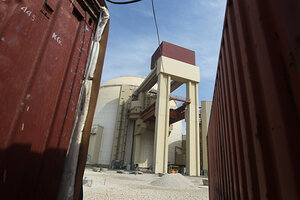Iran loads fuel rods into Bushehr nuclear power plant
Loading fuel roads into the Bushehr power plant marks the end of long delays in bringing online the center of Iran’s nuclear power program.

The reactor building of the Bushehr nuclear power plant is seen at center, just outside the southern city of Bushehr, Iran, on Oct. 26. Iran began on Tuesday loading fuel rods into the core of Bushehr, marking the end of long delays in bringing online the plant at the center of Iran’s nuclear power program.
Majid Asgaripour/Mehr News Agency/AP
Cairo
• A daily summary of global reports on security issues.
Iran today began loading fuel rods into the core of its first nuclear power plant, saying the reactor in Bushehr would begin operation by January.
If confirmed, it would mark the end of long delays in bringing online the plant at the center of Iran’s nuclear power program. The last time Iran proclaimed it was ready to power up the Bushehr plant, in August, it sparked alarm that it could be used to create fuel for weapons, although the United States recently withdrew its opposition to the 1,000-megawatt plant.
The move comes as the European Union is pressuring Iran to hold talks on its nuclear program next month. The West accuses Iran of pursuing nuclear weapons, which Iran denies, saying the plant is only for civilian power. Nuclear fuel requires enrichment to 3.5 percent, while weapons grade fuel requires enrichment to 90 percent.
The progress at the nuclear reactor was reported by Iran’s state-run Press TV on Tuesday. The nuclear reactor would begin operating after all 163 fuel rods are inserted into the core, and is expected to begin generating electricity by early 2011, according to Press TV. Iran has declared plans to build 20 nuclear power plants in the next 20 years.
The New York Times reports that Iran’s Foreign Ministry spokesman said the country had succeeded in its “peaceful nuclear activities” despite political pressure and sanctions. “The Bushehr power plant is a major project which will help us to take one step toward future alternative energy supplies,” he said. “We will also pursue our peaceful nuclear activities in other areas.”
Since June the UN, the EU, and the US have passed sanctions against Iran. On Friday, reported Reuters, EU Foreign affairs head Catherine Ashton urged Iran to conduct talks on Iran’s nuclear program in Vienna in November with United States, Russia, France, Britain, China, and Germany.
The Bushehr nuclear reactor has a long history of delays. Iran began building the plant in 1975, but its contract with Germany was derailed by the Islamic Revolution four years later. Iran inked a deal with Russia to finish the plant in 1995, but it was repeatedly delayed.
The latest delay was in August, when the fuel rods were delivered to the plant and scheduled to be loaded into the nuclear reactor. Many questioned if the delay came from the Stuxnet computer virus found on computers at the site, as The Christian Science Monitor reported. Iran denied the virus was the reason for the delay.
According to the Times, the US dropped opposition to the plant after Russia “provided assurances” that the spent fuel rods would not be used to create weapons-grade plutonium. The used fuel rods are supposed to be collected by Russian nuclear officials under the supervision of the International Atomic Energy Agency (IAEA), the UN’s nuclear watchdog, reports Israeli newspaper Haaretz. The Times reports that it is unclear whether the IAEA is currently supervising the fuel loading as agreed.
Under its normal procedures, IAEA inspectors would oversee the final processes of fuel-loading and then seal the core of the reactor to prevent tampering. The reactor is also supposed to be kept under surveillance by closed circuit television cameras that would detect any movement of fuel.
The Bushehr reactor … is separate from Iran’s other operations at which it is seeking to enrich uranium. Iran says it wants the enrichment facilities to provide fuel for future reactor use and a for a medical research reactor. But the West and Israel suspect those programs are designed to produce weapons-grade fuel.
